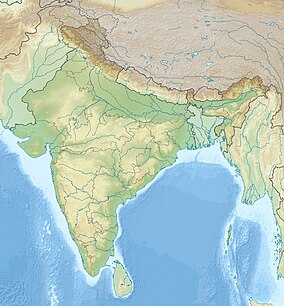Raimona National Park
| Raimona National Park | |
|---|---|
 Western parts of Raimona National Park | |
| Location | Gossaigaon, Kokrajhar District, Assam |
| Nearest city | Gossaigaon |
| Coordinates | 26°39′35″N 89°58′34″E / 26.65972°N 89.97611°E |
| Area | 422 km2 (163 sq mi) |
| Created | 9 June 2021 |
| Governing body | Government of Assam |
Raimona National Park is located in extreme western part of Assam, India. It is spread across Gossaigaon and Kokrajhar subdivisions of Kokrajhar district of Bodoland Territorial Region.[1]
History
[edit]Raimona National Park was initially recommended as Ripu-Chirang Wildlife Sanctuary being part of Ripu Reserved Forest and Chirang Reserved Forest being adjacent a part of it was also mooted to be within. Those were made owing to its significance for conservation of Asian elephants, gaur or Indian "bison" and golden langur, all of which have large populations in the area.[2][3][4]
Raimona National Park was declared a national park on 5 June 2021 by the announcement of the Chief Minister of Assam on the occasion of World Environment Day at Gandhi Mandap, Guwahati. On 9 June 2021, its national park status was announced in Assam Gazette Notification no.FRW.02/2021/27 dtd. 8 June 2021.[citation needed] It is a part of a contiguous forest patch with an area of 422 km2 (163 sq mi) covering the northern part of the notified Ripu Reserve Forest with 508.62 km2 (196.38 sq mi), which forms the westernmost buffer to Manas Tiger Reserve in the foothills of Eastern Himalaya Biodiversity Hotspot.[citation needed]
Geography
[edit]Raimona National Park is located in the Himalayan foothills. Its boundary is marked by the Sankosh River in the west, along the border between West Bengal and Assam, Saralbhanga River in the north and east, and part of Ripu Reserve Forest on the south.[citation needed]
Biodiversity
[edit]Flora
[edit]Raimona National Park harbours 380 varieties of plants and orchids.[citation needed]
Fauna
[edit]

Raimona National Park is home to slow loris, Assamese macaque, Rhesus monkey and golden langur.[5] It also harbours Chinese pangolin, dhole, Himalayan black bear, crab-eating mongoose, jungle cat, leopard cat, Asian golden cat, Bengal tiger, leopard, clouded leopard, Asian elephant, gaur, Himalayan serow, sambar, chital, hog deer, barking deer, Himalayan porcupine and hispid hare.[6]
Avifauna
[edit]Raimona National Park is an important bird and biodiversity area.[7] Avifauna includes white-bellied heron, swamp francolin, pheasant, grey peacock pheasant, Indian peafowl, Oriental darter, lesser adjutant, collared falconet, slender-billed vulture, white-backed vulture, besra, black baza, Jerdon's baza, osprey, Bengal florican, now perhaps extirpated, ibisbill, green imperial pigeon, mountain imperial pigeon, red-breasted parakeet, great pied hornbill, occasional rufous-necked and Indian grey hornbills, wreathed hornbill, hill myna and scaly thrush.[8]
References
[edit]- ^ "Raimona becomes Assam's sixth national park". The News Mill. 2021. Retrieved 5 June 2021.
- ^ Choudhury, A.U. (1999). "Status and conservation of the Asian elephant Elephas maximus in north-eastern India". Mammal Review. 29 (3): 141–173.
- ^ Choudhury, A.U. (2002). "Distribution and conservation of the gaur Bos gaurus in the Indian Sub-continent". Mammal Review. 32 (3): 199–226.
- ^ Choudhury, A.U. (2002). "Golden langur Trachypithecus geei threatened by habitat fragmentation". Zoo's Print Journal. 17 (2): 699–703.
- ^ Choudhury, A. U. (1989). Primates of Assam: their distribution, habitat and status. Guwahati: Gauhati University.
- ^ Choudhury, A. U. (2013). The mammals of North East India. Guwahati: Gibbon Books and the Rhino Foundation for Nature in NE India. ISBN 978-9380652023.
- ^ Rahmani, A.R. et al. (2016). Important Bird & Biodiversity Areas in India. Vol. 1. Bombay Natural History Society and Bird Life International.
- ^ Choudhury, A. U. (2000). The birds of Assam. Guwahati: Gibbon Books and the WWF-India NE Region Office. ISBN 8190086618.



